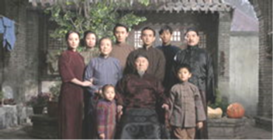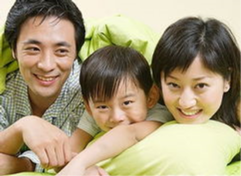Family is the cell of the society, and rulers of past dynasties all paid great attention to the stability of families, which affected the stability of the society and the ruler’s system of government as well.

 In the Past
In the Past
The Chinese family as it is described in the Story of the Stone (hong lou meng, Qing dyansty) is the result of a long historical development.
The Chinese for “family” is Jia, which generally means the basic family group, those who are related by blood, marriage, or adoption, living and managing their finances together. In a Jia, the males are all blood relations. Sons live in their father's house with their wives, who have been brought in from outside the family. As soon as daughters come of age, they are married out, that is, they join another Jia. They are members of their parents’ Jia only as long as they are unmarried. During the wedding ceremony, daughters officially end their ties to their father’s patriline, and are promised to serve their new family, including its ancestors. Males are permanent members of the family they were born into; females, however, are expected to eventually leave their born family. Women, therefore, belong to a place in a patriline -- that of their husband, not their father -- when they give birth to a son.

The Jia shares living space and finances. One male, the patriarch (the oldest competent male) has the most authority in all family matters. In the ideal Jia, three, four, or five generations live under one roof. Sons obediently follow their father’s direction in choosing a career and a wife, and every member of the Jia works together for a single aim: keeping and increasing the Jia’s wealth and status. Such a large, multi-generational Jia can grow to be very complex.
For women and children, especially in the large, wealthy, elite families, the Jia was essentially both the center and the limit of the world. The wealth, reputation, and status of the Jia, however, rested largely on the success or failure of men operating outside the Jia.
 Modern Chinese Family
Modern Chinese Family
According to latest statistics, China has 430 million families (the year 2014), with 3.13 people per household on average. In general, a Chinese family is made up of a couple and their children, but big families with three or more generations can also be found in China. With the pursuit of personal freedom, the trend of forming small families with only directly related members is now popular.
In the past, each Chinese family had a “head”, who had absolute authority at home, and had the final say in family affairs. But now in most Chinese families, the husband and wife, or a couple with other family members, work out together the household plans, and decide family affairs through consultation.

Moreover, family members share the housework, making the division of labor at home more reasonable; and the husband and wife support each other’s work.
Chinese people have the tradition of respecting the old and loving the young. Though many young couples do not live with their parents, they keep close contact with them. Grown-up children have the duty to support and help their parents. The Chinese people attach great importance to relations between family members and relatives, and treasure their parents, children, brothers and sister, uncles, aunts and other relatives.
Family planning has been pushed forward as one of the basic state policies in China. The basic requirements of family planning are late marriages and late childbearing, so as to have fewer but healthier babies, especially one child per couple. But a flexible family planning policy is adopted for rural people and ethnic minorities: in rural areas, couples may have a second baby in exceptional cases, but must wait several years after the birth of the first child; in areas inhabited by minority peoples, each ethnic group may work out different regulations in accordance with its wish, population, natural resources, economy, culture and customs -- now in general a couple may have a second baby, or a third child in some places. As for ethnic minorities with extremely small populations, a couple may have as many children as they want.
Nowadays, universal two-child or three-child policy has been carried out to meet with the country’s aging trend.
1. Taking the Story of the Stone for example, tell your foreign friends about Chinese families.
2. What’s difference between modern Chinese family and Chinese family in the past?



